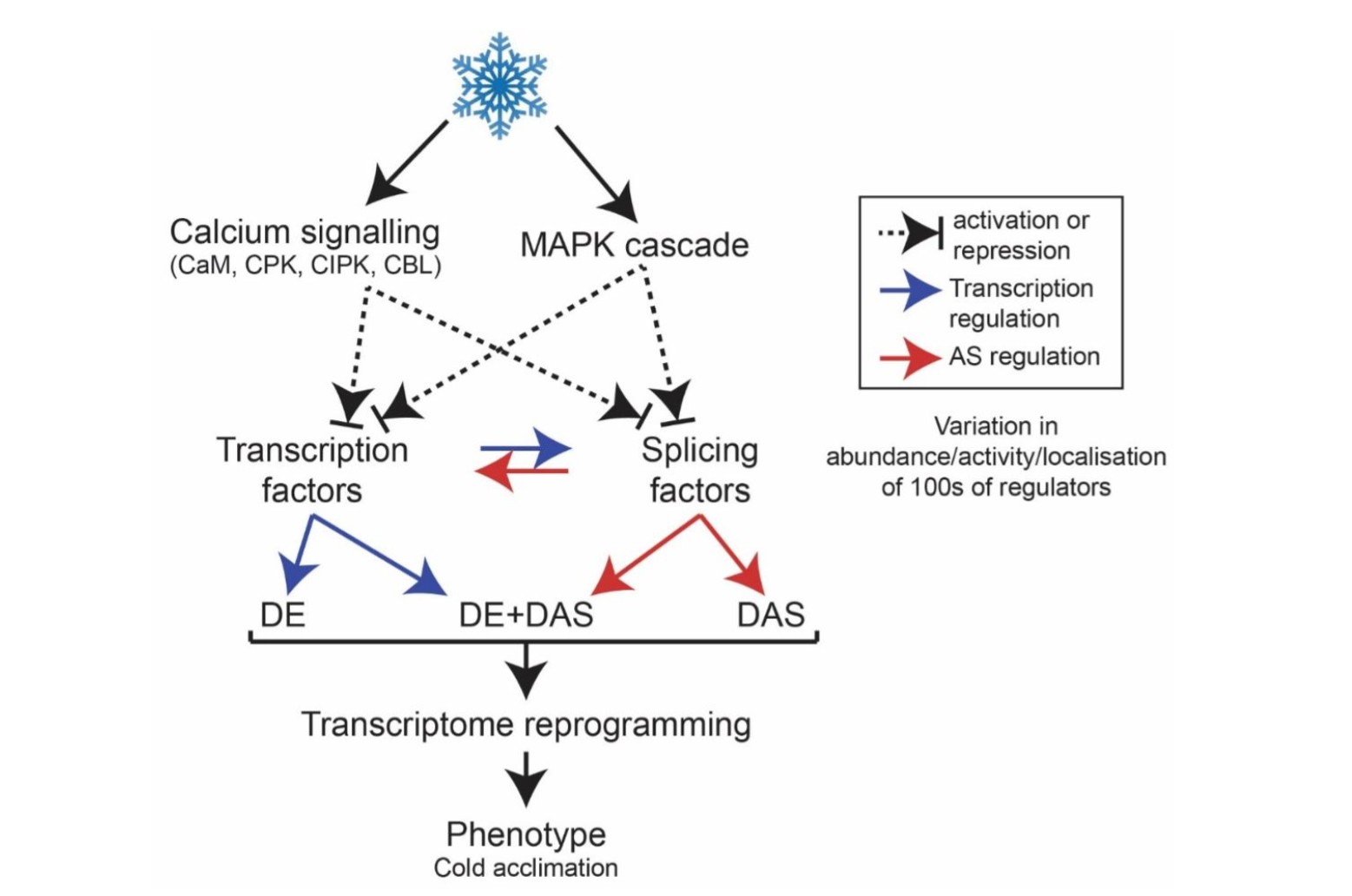博文
Plant Cell:拟南芥基因可变剪切影响寒冷响应
||
Rapid and dynamic alternative splicing impacts the Arabidopsis cold response transcriptome
First author: Cristiane P G Calixto; Affiliations: University of Dundee (邓迪大学): Dundee, United Kingdom
Corresponding author: John W.S. Brown
Plants have adapted to tolerate and survive constantly changing environmental conditions by re-programming gene expression. The dynamics of the contribution of alternative splicing (AS) to stress responses are unknown. RNA-sequencing of a time-series of Arabidopsis thalianaplants exposed to cold determines the timing of significant AS changes. This shows a massive and rapid AS response with coincident waves of transcriptional and AS activity occurring in the first few hours of temperature reduction, and further AS throughout the cold. In particular, hundreds of genes showed changes in expression due to rapidly occurring AS in response to cold ("early AS" genes); these included numerous novel cold-responsive transcription factors and splicing factors/RNA-binding proteins regulated only by AS. The speed and sensitivity to small temperature changes of AS of some of these genes suggest that fine-tuning expression via AS pathways contributes to the thermo-plasticity (热塑性) of expression. Four "early AS" splicing regulatory genes have been shown previously to be required for freezing tolerance (耐冻性) and acclimation (适应环境); we provide evidence of a fifth gene, U2B"-LIKE. Such factors likely drive cascades of AS of downstream genes which alongside transcription modulate transcriptome reprogramming that together govern the physiological and survival responses of plants to low temperature.
植物通过重编程基因表达来忍耐各种变化的环境条件,适应并存活下来。可变剪切AS对于胁迫响应的作用还不清楚。作者通过对低温处理的拟南芥进行了转录组时间序列分析,研究AS随时间的显著变化。作者鉴定了大量快速响应低温的AS,并与刚开始低温处理几个小时内的转录和AS活性的波动一致。作者还鉴定了数百个基因的AS能够快速响应于寒冷,定义为”早期AS”,这些基因包括了很多新的寒冷响应的转录调控因子和仅受AS调控的剪切因子/RNA结合蛋白。这些基因中某些成员的AS能够快速响应于温度的微弱变化,表明通过AS通路的精细表达调控作用于基因表达的热塑性。四个”早期AS”剪切调控基因在之前的报道中作用于植物的冰冻抗性和环境适应,本文的研究又增加了一个基因,即U2B"-LIKE。这些因子可能通过驱动AS下游基因的级联,同时通过转录改变转录组重编程,最终赋予植物对低温的生理和生存响应。
通讯:John W.S. Brown (http://www.lifesci.dundee.ac.uk/people/john-brown)
研究方向:植物基因可变剪切。
doi: https://doi.org/10.1105/tpc.18.00177
Journal: Plant Cell
First Published date: 15 May, 2018
(P.S. 原文下载:链接:https://pan.baidu.com/s/1qFiSsqwlF_7JjmGMbedfhQ 密码:dmu6)
https://blog.sciencenet.cn/blog-3158122-1114577.html
上一篇:Plant Biotechnol J:中国梨石细胞木质化的分子调控机制
下一篇:PNAS:植物氮信号转导的时间序列转录组分析
全部作者的其他最新博文
- • Plant Physiology:CsMADS3促进柑果中的叶绿素降解和类胡萝卜素合成(华中农业大学)
- • Molecular Plant:LBD11-ROS反馈调节作用于拟南芥的维管形成层增殖和次生生长(浦项科技大学)
- • Science Advances:根结线虫通过调控植物的CLE3-CLV1模块,促进侵染进程(日本熊本大学)
- • Nature Communications:油菜素内酯参与植物营养生长期转变的分子机制解析(浙江农林大学)
- • Current Biology:光合作用产生的蔗糖驱动侧根“生物钟”(德国弗莱堡大学)
- • PNAS:花同源异型基因在叶中被抑制、花中被激活的分子机制(南卡罗来纳大学)


